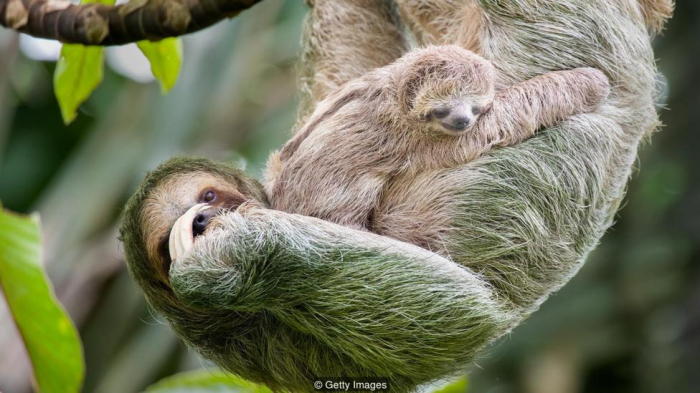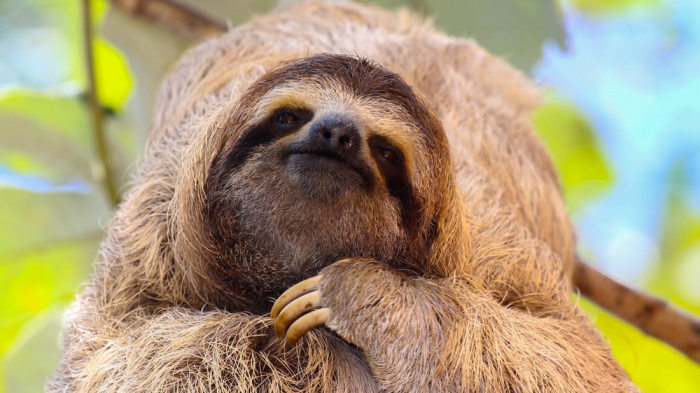Sloths, as their name betrays, have little need to rush. For the most part, they live high in the branches of the forests which stretch across Central and South America, only coming down to the ground to defecate. And the life they lead is very much in slow motion.
Just why sloths move so slowly is due to some peculiar evolutionary tricks.
Modern-day sloths – the three-toed sloth and the two-toed sloth – are much smaller versions of the sloths that inhabited the prehistoric world. Giant sloths, some that would weigh up to several tonnes, walked on the ground during the last ice age until around 11,000 years ago, foraging from the trees by standing up on their hind legs to reach into the foliage.
“What changed was a combination of both going up into the trees, and having a diet almost entirely based on leaves,” says Camila Mazzoni of the Leibniz Institute for Zoo and Wildlife Research in Germany.
“The leaf diet is very poor in nutrients and the intake of calories is very low. Because of this they have to have a very slow metabolic rate to cope with this low calorific intake.”
And part of that comes down to where it is they live.

Sloths spend most of their lives in trees, away from rainforest predators (Credit: Getty Images)
All six species of sloths live in tropical forests. It’s a hot and humid environment that means some of the normal advantages of an endothermic system aren’t really required – the environment’s already warm, so you don’t have to expend an enormous amount of energy to keep your muscles and cardiovascular system warm. So sloths don’t.
Being a mammal has its benefits. Capable of regulating their body temperature internally, they can live in colder climates – much colder than reptiles or other cold-blooded animals.
But this hot-blooded evolutional trick has a few drawbacks as well. In order to fuel this energy-hungry system, mammals need to eat a lot and often to keep the muscles needed for movement warm. It’s why mammals can still dart about on a cool day, while lizards remain sluggish – if they move at all.
This endothermic adaptation has allowed mammals to colonise most of the environments on Earth – including the freezing cold expanses of both poles.
But elsewhere, some mammals have abandoned the endothermic traits that evolution has gifted them. In doing so, they’ve adopted a go-slow, energy-saving lifestyle more similar to cold-blooded animals.
“The thermo-regulation that most mammals have to do requires a lot of energy,” says Mazzoni. “But because sloths don’t have it, it means they require a lot less energy.
“But this means they can only live in the tropics, and not high up in the mountains where the temperature gets quite low. Having said that, the two-toed sloth is a bit more flexible, and will go a bit higher into the mountains in Costa Rica.”

A sloth's diet of leaves is nurtitionally poor and low in calories (Credit: Getty Images)
The sloths’ tree-based life cycle means they spend very little time at risk from predators like the jaguar. This is another reason why lightning-fast reactions – and the enormous amount of energy needed to fuel them – just aren’t needed. “They have this intimate relationship with the trees,” says Mazzoni. “They depend on them.”
She says sloths often “go up to the top of the canopy in the morning to get some energy from the Sun and when it gets really hot they go back down to the shade of the trees”. This behaviour is much more typical of cold-blooded animals – lizards and other reptiles – than it is of other mammals.
Becky Cliffe, a British zoologist who works at Costa Rica’s Sloth Conservation Foundation, says it is only when you see sloths in the wild that you truly appreciate just how slow they are. “You know they move slowly, but then you look at one and every part of their body – when they turn their head, or even when they blink – it’s all done so slowly. You have to spend a lot of time out in [the] field to see one.”
Look closely at a sloth and its fur will often also have a green shade to it. It might be tempting to assume that the animals have become so sedentary that they have become home to moss and algae from the trees around them. But this misses something far more fascinating, says Mazzoni.
“Their hair is modified and has these kind of openings in which the algae and fungi can grow,” she says. “It’s not because they’re slow. We know there’s some kind of symbiotic relationship going on there.”
What are these algae good for? Many scientists are trying to figure that out. “It could be that it’s good for the sloths’ camouflage,” adds Mazzoni. The green algae and fungi could help sloths blend in to the background of the forest canopy.
“It could also be a way for the sloths to get extra protein,” she says, noting that sloths have sometimes been seen to lick the algae growing on their fur. The fungal growths may also help keep down the number of parasites. “Their fur is almost completely water resistant, and impedes a lot of parasites. Sloths have fewer parasites than other mammals of a similar size.”

Baby sloths must constantly suckle because the mother only produces tiny amounts of milk at a time (Credit: Getty Images)
Among the other hallmarks of mammalian life that sloths have dispensed with is the amount of milk nursing mothers produce for their offspring.
“Sloth mothers don’t store large amounts of milk, so it just comes out drop by drop,” says Cliffe. The young attach themselves close to the nipple, and then feed as the milk dribbles out.
The sloth’s steady-as-you-go approach to life shouldn’t be mistaken for laziness, however
Cliffe’s years watching sloths in the Costa Rican jungle has given her much insight into their behaviour. “They don’t jump and they don’t run. But they do have the most incredibly strong arms. If a human and a sloth had an arms wrestle, the sloth would definitely win.” But the sloth’s legs – which aren’t needed for breakneck speed or even supporting their full weight most of the time – don’t have the same muscle mass.
The sloth’s steady-as-you-go approach to life shouldn’t be mistaken for laziness, however, says Cliffe. “They’re not lazy. The howler monkeys that live in the forests sleep for up to 18 hours a day, and the sloths only sleep for around 10.”
Had sloths not ended up living in a hot, humid environment covered in trees, they might be sprightlier, living at a quicker pace. But over countless generations they have arrived at a pace of life perfectly suited to their environment.
“They show that you don’t have to run around all the time trying to find food,” says Cliffe. “They’ve relaxed the whole system.”
BBC Future
More about: sloths
















































